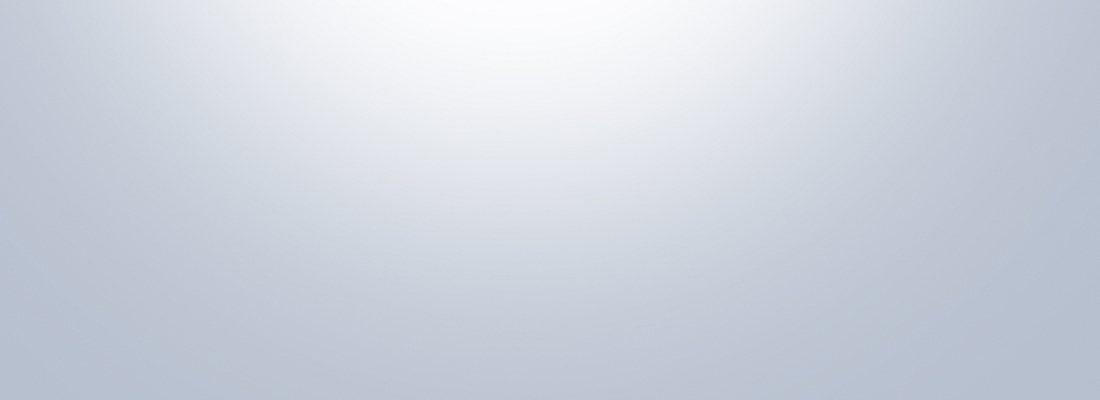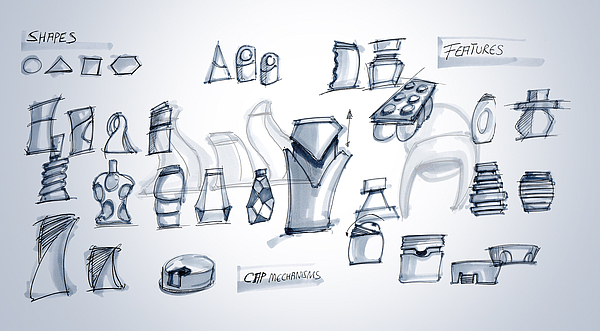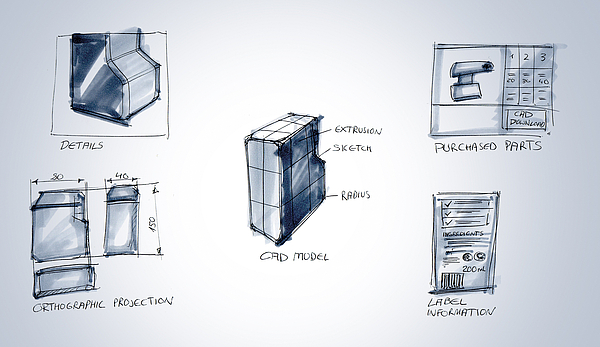

Industrial design is about finding the optimal shape for industrially manufactured products. This form-finding is not a question of taste. One does not wait for an inspiration to make the product merely prettier. Rather, a clearly defined design process is followed.
The aim of this design process is to create the optimal shape of the product by taking into account technical, economic and human factors. For this purpose, a vision is necessary in order to present the project in image and text. Implementation of the vision takes place in four phases: analysis, ideation, concept and development. It does not matter what kind of design is involved: whether for consumer goods, machines or packaging, the design process always remains the same. And it runs “iteratively”, so to speak, in loops, in which the sequences repeat themselves at regular intervals. So you can react quickly and with little effort in the event of changes. At the end of each loop, the project team and the client meet to discuss the design in what is called a “review”.
By comparison, the waterfall model is usually used in development projects for industrial products that are technical and functional in nature. This model runs linearly, and deals with the four project phases in sequence, so that the result can be presented at the end. The opposite of the agile approach. There is also no short-term vision, but the defined requirements and the functional specification, which take a long time. In most cases, waterfall model projects are concluded with several deadline extensions, since the first presentation of results is rarely satisfactory. Also, there are often delays during the project phases. This is understandable, because a development project is not like building a house, where you already know how to do it. The requirements during product development are constantly changing. It is only in the course of the project that it becomes clear which functions of the product are actually necessary. However, it is very time-consuming and costly to integrate functions later.
In present-day design processes, the agile methodology is followed in order to avoid delays in the project. Originally, the agile approach was developed at the beginning of the 1990s and originated from the software development, as development projects became ever more complex and companies could not hit the deadlines on time. For example, there are frameworks such as “Scrum” and “Kanban”, which used agile procedure for the first time.
I will be describing below the agile design process and introduce a fictitious task: what might the packaging design of a product family for dermatological cosmetic products look like, which should be maintained by its design in the market?
Vision – The vision is the road map for project participants. Here everyone sees if he is on the right track
The vision is the central element in the agile design process: everything proceeds from the vision, which is direction-oriented for us as a project participant. The client describes his wishes for the packaging design in a brief description with approximate visualisation.
To this end, central questions of marketing have already been addressed: what are the target groups? Who is the main competitor? A positioning diagram is also of advantage, in order to identify exactly where the product is aimed at: is its appearance modern or traditional, upmarket or downmarket?
For example: The packaging design of our dermaceutical product line is designed for men and women aged 16 to 66. In contrast to our main competitor XY, it has a high-quality, modern look, and despite the much higher price stands on every drugstore shelf.
Analysis – Not only the product is important, but also all the trappings
First, we have to deal with the actualities of the project. It is important to take a closer look at the product. Although product analysis is less fun than the creative part, it is nevertheless important to understand problems and achieve an optimal result.
In the analysis phase, we collect various information, starting with: What does the existing product look like? How does it affect me? How does it feel in the user’s hands? In the same way, we also examine the competitors’ products optically, haptically and ergonomically, and summarize the findings in an analytical document.
Further analysis criteria are: Which labelling method has been used for the existing product? What alternatives are there? What type of material is the packaging made of? What alternative options are there? We collect valuable information for new solutions.
In order to find out to what extent industrial property rights exist in packaging, we should make a patent search. The designs are usually protected as utility models or design patents. Utility models are functional elements such as closure mechanisms or protective coatings. Design patents are optical elements such as the packaging or the colouring. With a lot of time and little money you can conduct a patent search. However, if you do not have time, you should hire a patent agent.
Researching is easy nowadays. But despite the many possibilities involved, there are efficient and inefficient ways. You can search through books, newspapers, magazines and the internet. But you can also get in touch with people who are experts in the field. This can often be more efficient and reliable.

Ideation – Crazy ideas are welcome here, criticism has to remain outside
Next comes the particularly creative part of the design process: the ideation. We collect ideas on how our dermaceutical product family can be designed. Since various elements of the product are designed (container, cap mechanism, label, etc.), it can be very useful to hold several workshops for finding ideas. In the ideation phase, everything is permitted and nothing is forbidden. We filter and criticize only afterwards.
If the ideas do not come right away, we can research further. What types of caps exist on the market? What additional features are there? These questions often arise when we are concerned with ideas. Nevertheless, we can jump back to the analysis phase in the agile method. This is an advantage, because in another loop, we gather information we have not yet encountered.
We can also build a shape alphabet to get a variety of shape studies. A shape alphabet is a good way to proceed methodically and effectively. We take basic shapes such as triangle, square, hexagon or circle, and combine them with other basic shapes. This creates all possible combinations and variants of the container shape to inspire us for the actual concept.
If we continue to think at this stage, it is also noticeable that our finished product will be placed in the store after transport. It is also possible to showcase the products on a sales display in order to draw the customer’s attention: either as a standing display or as a counter display. So we can also deal with displays again and research on the internet.
At the end of our ideas, we structure, assess and select the sketches. The best ideas are used for conceptual design.

Concept – The design is thought through from the beginning to the end of the product life
On the basis of the ideas selected, we now create designs. We develop functional and formal design approaches. The concept should be a coherent description of the product and the associated elements in both visual and textual form.
What does the product look like? What shapes and colours are used? How is the product manufactured and what material is it made of? What do the graphics look like, and how are they applied to the packaging? How is the product transported? What does the product family look like when it is displayed in the store next to competitive products?
The product life of packaging begins with the completion in the factory, which includes manufacturing and assembly. Our packaging can consist of the material PET, for example, and can be produced by stretch blow-moulding. Subsequently, the goods are transported to the stores. The size of the packaging can be adapted to the pallet size in order to make optimum use of space and to save costs. On the shelf, the product should be visually appealing to the customers and make them want to buy it. When used, it should fit perfectly in the hand and be convenient to open. The product should also be recyclable and therefore environment-friendly. All these phases of product life are taken up and incorporated into our product design. If some information is still missing, we can always return to the analysis and ideation. This agility is necessary in order to be able to develop the product holistically.
The concept will examine whether the project is inherently viable and leads to the intended goal: will the vision be put into practice with this concept? Is the team on the right track? After the visualization of the concepts, one design is selected for development.

Development – It is now about details and compromises. This phase has got a lot to offer
If the concept has been approved so far, we can proceed to the development phase. This phase is often underestimated. A well thought-out concept is a prerequisite for efficient elaboration, but the devil is always in the details. Because here are other points that we have not thought of so far. Be it barcodes, colour values ??or print enhancements on the packaging.
It is also important for us to return to the analysis phase and to research the necessary information. If there are several possibilities for placing elements, more variants are necessary in the concept phase in order to make an objective decision.
For technically complex elements such as cap opening mechanisms, we should consider the use of outsourced parts. These have a long development phase behind them and do not have to be re-invented. In the case of detailed elaborations such as mould separations, joints and radii, we have to discuss with the designers whether these can be implemented as intended. Often several loops have to be processed until the result is satisfactory for everyone involved. This is where most compromises are made.
In the development phase, we also define the final dimensions of the product. And we check once again whether the product is suitable for optimally economical transport. After the product has been launched, many transport journeys take place, for which the costs can be kept low by a well thought-out design.
Review – Together we look back at the fruits of our work. Again and again
After we have created a presentable draft, we meet with the client to discuss the design. The review is conducted at the end of each loop in the design process. Regardless of the project phases involved, we meet with the client at the same time intervals to inspect the results. We present the design, and the client gives his feedback, so that we can adapt the most important requirements. After we have recorded the feedback of our client, we get back to work and plan the next loop in the agile design process. By the end of the project, we will hand over the final design, detailed and documented.
This was a brief insight into the agile design process, and how to tackle a task. Regardless of whether you already have experience in a particular industry or still have to collect a lot of information, you will always learn from the agile process and gain new insights. To be honest, one never gets the “optimal” product at the end of the project, but that is not the aspiration. You always want to develop an “optimised” product, and you want to control time and costs. If you work consistently and carry out a project in short, regular loops, you will be able to reach the optimised product faster. You will also complete the project at the scheduled time within the planned budget. Then everyone involved will be very happy with the result.

The comPETence center provides your organisation with a dynamic, cost effective way to promote your products and services.

magazine
Find our premium articles, interviews, reports and more
in 3 issues in 2025.







